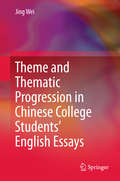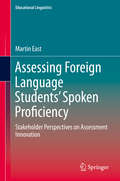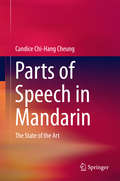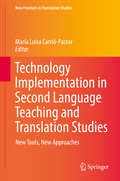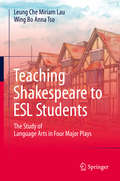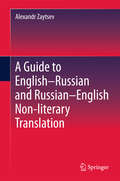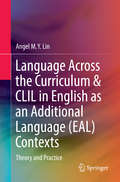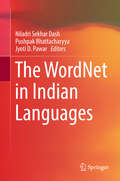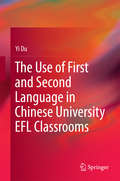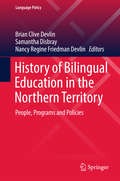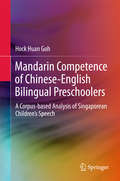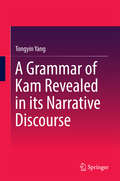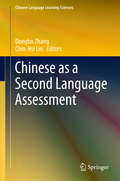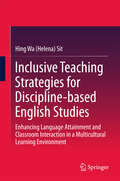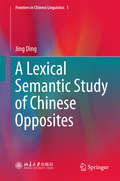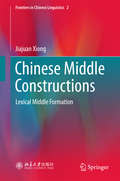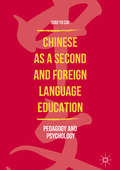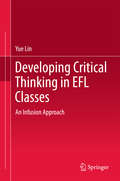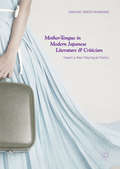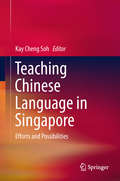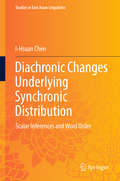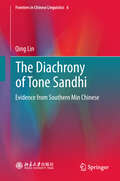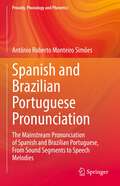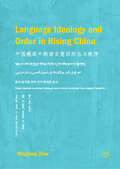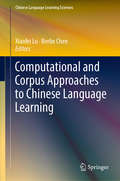- Table View
- List View
Theme and Thematic Progression in Chinese College Students' English Essays
by Jing WeiThis book focuses on how instruction affects English learners' use of Theme and thematic progression (thematic organization). While thematic organization in learner English has been extensively studied, little research has been done to investigate the effects of instruction on the use of Theme and thematic progression. Adopting a Systemic Functional Grammar approach, this study explores how a ten-week instruction on thematic organization affects Chinese college students' use of Theme and thematic progression by comparing their English essays before and after the instruction, with native-speaker essays as the research baseline. Second-language acquisition researchers, curriculum developers and foreign language teachers will find this book useful as it not only presents a clear and detailed report of how Chinese college students learn to make better thematic choices, but also provides a well-developed instructional package on Theme and thematic progression.
Assessing Foreign Language Students' Spoken Proficiency: Stakeholder Perspectives on Assessment Innovation (Educational Linguistics #26)
by Martin EastThis book presents an indepth study of assessment innovation and its impact on teaching and learning. The context is New Zealand, and the focus is additional languages other than English and the recent introduction of a radical new assessment of students' spoken proficiency, called interact. The book crosses the traditional theoretical and methodological boundaries associated with language testing research, which focuses on assessment performance, and presents an alternative approach where stakeholders become the centre of interest. It advances our understanding of how assessment innovation impacts on two key groups - teachers and students in schools - based on data collected from a substantial twoyear research project. It presents an account of these stakeholders' perceptions of the validity and usefulness of the new assessment in comparison with the more traditional test that it has replaced. Assessing Foreign Language Students' Spoken Proficiency makes an outstanding and original contribution to the field of second and foreign language teaching, providing a theory and research-based account of the development of a learner-centred approach to oral proficiency assessment. It is an important resource for teachers and teacher educators as well as assessment and curriculum specialists worldwide. It deserves to be widely read.
Parts of Speech in Mandarin
by Candice Chi-Hang CheungThis book offers a comprehensive survey of the major parts of speech in Mandarin. Seeking to identify the sets of universal and language-specific categories, it compares the range of categories available in Mandarin and the Indo-European languages and establishes six universal categories - nouns, verbs, adjectives, adverbs, prepositions and conjunctions - and three language-specific ones, namely classifiers, localizers and sentence-final particles. Incorporating insights from recent research findings and the diachronic development of the language, the book sheds new light on the factors that contribute to the long-standing debate on the categorical status of adjectives, prepositions and localizers in the extant literature. Bringing together the earlier general descriptions and the latest advances, it is broadly accessible to non-native and native speakers of the language and offers an ideal reference source for all students and scholars who are interested in studying the parts of speech in Mandarin.
Technology Implementation in Second Language Teaching and Translation Studies
by María Luisa Carrió-PastorThis monograph mainly focuses on the idea that language teaching in higher education involves making use of new approaches and technology. It identifies the key determinants of the materials needed to improve language teaching on the basis of the actual experimental research included in the respective contributions. Thanks to its unique perspective, the book offers a distinctive approach to addressing empirical research on second language teaching, translator training and technology. As universities are some of the best arenas for analyzing teaching techniques for various subjects, higher education teachers can use this book to thoroughly prepare for the application of pilot studies and learn more about students' responses to new teaching and translation techniques. An enlightening guide for scholars and students with an academic interest in acquiring the basic principles of language teaching and translation, this book mainly provides actual cases in which the implementation of technology was useful to second language teachers and translation trainers. As the authors are experienced scholars, readers will not only come to understand how to use new teaching strategies, but also discover that the proposals described in each chapter can be useful to any level of second language training for teachers and translators.
Teaching Shakespeare to ESL Students
by Leung Che Miriam Lau Wing Bo Anna TsoThis is a teacher's resource book tailor-made for EFL teachers who want to bring Shakespeare into their classes. It includes forty innovative lesson plans with ready-to-use worksheets, hands-on games and student-oriented activities that help EFL learners achieve higher levels of English proficiency and cultural sensitivity. By introducing the plots, characters, and language arts employed in Macbeth, Romeo and Juliet, The Taming of the Shrew, and The Merchant of Venice, the book conveys English grammatical rules and aspects like a walk in the garden; complicated rhetorical features such as stress, meter, rhyme, homonymy, irony, simile, metaphor, euphemism, parallelism, unusual word order, etc. are taught through meaning-driven games and exercises. Besides developing EFL learners' English language skills, it also includes practical extended tasks that enhance higher-order thinking skills, encouraging reflection on the central themes in Shakespeare's plays.
A Guide to English-Russian and Russian-English Non-literary Translation
by Alexandr ZaytsevLying at the intersection of translatology, cognitive science and linguistics, this brief provides a comprehensive framework for studying, investigating and teaching English-Russian/Russian-English non-literary translation. It provides a holistic perspective on the process of non-literary translation, illustrating each of its steps with carefully analyzed real-life examples. Readers will learn how to choose and process multidimensional attention units in original texts by activating different types of knowledge, as well as how to effectively devise target-language matches for them using various translation techniques. It is rounded out with handy and feasible recommendations on the structure and content of an undergraduate course in translation. The abundance of examples makes it suitable not only for use in the classroom, but also for independent study.
Language Across the Curriculum & CLIL in English as an Additional Language (EAL) Contexts
by Angel M. Y. LinThis book will be of interest to a broad readership, regardless of whether they have a background in sociolinguistics, functional linguistics or genre theories. It presents an accessible "meta-language" (i. e. a language for talking about language) that is workable and usable for teachers and researchers from both language and content backgrounds, thus facilitating collaboration across content and language subject panels. Chapters 1 to 3 lay the theoretical foundation of this common meta-language by critically reviewing, systematically presenting and integrating key theoretical resources for teachers and researchers in this field. In turn, Chapters 4 to 7 focus on issues in pedagogy and assessment, and on school-based approaches to LAC and CLIL, drawing on both research studies and the experiences of front-line teachers and school administrators. Chapter 8 provides a critical and reflexive angle on the field by asking difficult questions regarding how LAC and CLIL are often situated in contexts characterized by inequality of access to the linguistic and cultural capitals, where the local languages of the students are usually neglected or viewed unfavourably in relation to the L2 in mainstream society, and where teachers are usually positioned as recipients of knowledge rather than makers of knowledge. In closing, Chapter 9 reviews the state of the art in the field and proposes directions for future inquiry.
The WordNet in Indian Languages
by Niladri Sekhar Dash Pushpak Bhattacharyya Jyoti D. PawarThis contributed volume discusses in detail the process of construction of a WordNet of 18 Indian languages, called "Indradhanush" (rainbow) in Hindi. It delves into the major challenges involved in developing a WordNet in a multilingual country like India, where the information spread across the languages needs utmost care in processing, synchronization and representation. The project has emerged from the need of millions of people to have access to relevant content in their native languages, and it provides a common interface for information sharing and reuse across the Indian languages. The chapters discuss important methods and strategies of language computation, language data processing, lexical selection and management, and language-specific synset collection and representation, which are of utmost value for the development of a WordNet in any language. The volume overall gives a clear picture of how WordNet is developed in Indian languages and how this can be utilized in similar projects for other languages. It includes illustrations, tables, flowcharts, and diagrams for easy comprehension. This volume is of interest to researchers working in the areas of language processing, machine translation, word sense disambiguation, culture studies, language corpus generation, language teaching, dictionary compilation, lexicographic queries, cross-lingual knowledge sharing, e-governance, and many other areas of linguistics and language technology.
The Use of First and Second Language in Chinese University EFL Classrooms
by Yi DuThis book investigates first language (L1) and second language (L2) use in Chinese university classrooms, focusing on the experiences of four Chinese EFL teachers who were teaching non-English major students at four different proficiency levels. It examines these four teachers' actual use of L1 and L2, including the distribution of their L1 and L2 use; the circumstances, functions and grammatical patterns of their language use; and their language use across different frames of classroom discourse. It also explores their attitudes and beliefs regarding this issue in depth, as well as their own perceptions of and reasons for their language use and possible influencing factors. Through its detailed analysis of the teachers' language use, as well as their respective beliefs and decision-making techniques, this book contributes to L2 teachers' professional development and L2 teaching in general, especially with regard to establishing a pedagogically principled approach to L1 and L2 use.
History of Bilingual Education in the Northern Territory
by Brian Clive Devlin Samantha Disbray Nancy Regine Friedman DevlinThis book provides the first detailed history of the Bilingual Education Program in the Northern Territory of Australia. This ambitious and innovative program began in 1973 and at different times it operated in English and 19 Aboriginal languages in 29 very remote schools. The book draws together the grassroots perspectives of Indigenous and non-Indigenous practitioners and researchers. Each chapter is based on rich practitioner experience, capturing bottom-up aspirations, achievements and reflections on this innovative, yet largely undocumented language and education program. The volume also makes use of a significant collection of 'grey literature' documents to trace the history of the program. An ethnographic approach has been used to integrate practitioner accounts into the contexts of broader social and political forces, education policy decisions and on-the-ground actions. Language in education policy is viewed at multiple, intersecting levels: from the interactions of individuals, communities of practice and bureaucracy, to national and global forces. The book offers valuable insights as it examines in detail the policy settings that helped and hindered bilingual education in the context of minority language rights in Australia and elsewhere.
Mandarin Competence of Chinese-English Bilingual Preschoolers
by Hock Huan GohThis book provides readers with a detailed sketch of the Mandarin competence of Chinese children in Singapore from different home language backgrounds. Their Mandarin competence is defined in terms of lexical diversity, syntactic complexity and code-switching tendency. The findings presented show that there are statistical differences in lexical diversity and syntactic complexity among the compared groups of children, and these differences in linguistic competence were found to be positively correlated to increased Mandarin exposure at home. They also demonstrate that there are statistical differences in code-switching tendency among the groups of children compared, which were found to be negatively correlated to increased exposure to Mandarin at home. A general relationship between home language exposure and Mandarin competence was established, although this relationship was found to be volatile, especially among children who are more bilingually exposed. This book shares these findings with linguists, language educators, and language policymakers, both local and international.
A Grammar of Kam Revealed in Its Narrative Discourse
by Tongyin YangThe Kam language of China possesses fifteen tones - more than any other language. Yet it has long been neglected as an area of research, especially from the perspective of discourse analysis. This study initiates the exploration of the interface between grammar and discourse by examining various aspects of Kam narrative discourse, and using a functional approach to reveal its structural properties. It also introduces the mechanism for phonological and syntactic variations, as well as classifier variants and sentence-final particles (SFPs) in discourse and word order variations. Finally, it discusses the influence of social setting on narrative structure and offers the most up-to-date ethnological and social information about the community.
Chinese as a Second Language Assessment (Chinese Language Learning Sciences)
by Dongbo Zhang Chin-Hsi LinThis book brings together 13 original research papers that address emerging issues in the assessment of Chinese as a Second Language (CSL) in five major areas, including standards in CSL assessment; development of CSL tests; assessment of diverse knowledge and skills; computer-supported assessment; and CSL assessment in relation to instruction and teachers' assessment competence. It goes beyond the psychometric testing of Chinese and provides cutting-edge examinations of the interfaces of assessment with sociology of language, acquisition, pedagogy, and modern technologies, as well as teacher education. Given its unique features and broad range of topics, the book offers an intriguing and valuable resource, not only for scholars and researchers but also teacher educators and assessment practitioners who are directly or indirectly involved in CSL assessment.
Inclusive Teaching Strategies for Discipline-based English Studies
by Hing Wa Helena SitThis book presents empirical findings that reveal various teaching strategies and responses from two sub-cultural groups of students, i. e. local Hong Kong and Mainland students, with regard to their English studies. It puts forward a constructive model for innovative teaching strategies to enhance language attainment and classroom interaction in a multicultural learning environment in Hong Kong. It highlights inclusive teaching strategies with instructional, inspirational and interactional components to accommodate diverse learners and promote their classroom interaction. In addition to contributing to innovation in higher education in Hong Kong, the lessons learned here can be universally applied to ESL/EFL teaching and education reform around the world. Further, they support better learning and teaching at universities in the context of internationalization. The book will above all benefit undergraduate students in ESL/EFL teacher training programs, and post-graduate research students in applied linguistics, language education and second language teacher education. It also offers a valuable reference book for university lectures in teacher education, researchers in higher education in China, and TESOL/TEFL instructors in English-speaking countries (the UK, USA, Canada, Australia, New Zealand etc. ).
A Lexical Semantic Study of Chinese Opposites (Frontiers in Chinese Linguistics #1)
by Jing DingThis book studies Chinese opposites. It uses a large corpus (GigaWord) to trace the behavior of opposite pairings' co-occurrence, focusing on the following questions: In what types of constructions, from window-size restricted and bi-syllabic to quad-syllabic, will the opposite pairings appear together? And, on a larger scale, i. e. in constrained-free contexts, in which syntactic frames will the opposite pairings appear together? The data suggests aspects that have been ignored by previous theoretical studies, such as the ordering rules in co-occurrent pairings, the differences between the three main sub-types of opposites (that is, antonym, complementary, converse) in discourse function distributions. The author also considers the features of this Chinese study and compares it to similar studies of English and Japanese. In all, it offers a practical view of how opposites are used in a certain language as a response to the puzzles lingering in theoretical fields. This study appeals to linguists, computational linguists and language-lovers. With numerous tables, illustrations and examples, it is easy to read but also encourages readers to link their personal instincts with the results from a large corpus to experience the beauty of language as a shared human resource.
Chinese Middle Constructions: Lexical Middle Formation (Frontiers in Chinese Linguistics #2)
by Jiajuan XiongThis book defines Chinese middle constructions as generic constructions, with their highest syntactically saturated argument always understood as an arbitrary one. This working definition sets "middle construction" apart from "middle voice" in that it can be instantiated by various constructions in Chinese. By scrutinizing these constructions in the framework of Generative Syntax, the book concludes that their formation takes place at the lexical level, without resorting to any syntactic mechanisms and thus that Chinese falls into the category of "lexical middle languages", which are in contrast to "syntactic middle languages".
Chinese as a Second and Foreign Language Education: Pedagogy and Psychology
by Qiao Yu CaiThis book presents key issues in the teaching of Chinese as a second or foreign language (TCSL or TCFL). It investigates how multimedia can help to assist TCSL/TCFL and explores practical effects of multimedia-assisted teaching at secondary schools in the Philippines. It addresses the psychology of TCSL/TCFL and discusses various recurring foreign graduate students concerns when learning academic Chinese in graduate institutes in Taiwan. It examines issues of educational assessment and testing, analyzing the validity of a self-made placement test for an immigrant Chinese program, as well as the psychological characteristics of adult learners and their implications for immigrant Chinese curriculum design. As foreign learners of Chinese grow exponentially, this cutting edge read conceptualizes the educational philosophy of TCSL/TCFL as a distinctive discipline.
Developing Critical Thinking in EFL Classes: An Infusion Approach
by Yue LinThis book presents an innovative teaching experiment and an analytical study of critical thinking and the sociocultural theory of learning to illustrate the cognitive learning development mechanisms. It addresses the issues in developing critical thinking, including the controversy surrounding the definition, measurement and teaching of critical thinking, particularly in the L2 context.The book explains how infusion-thinking lessons can be structured to help students develop critical thinking along with language learning. Further, it uses a case study as a real-world example to examine the applicability and feasibility of infusion-thinking lessons in the EFL context and their effectiveness in developing students’ critical thinking and language learning.Packed with thinking activities and techniques, this practical, hands-on manual provides original ideas and empirical data, giving teachers everything they need to plan their lessons to improve students’ critical thinking within language courses and evaluate their teaching.
Mother-Tongue in Modern Japanese Literature and Criticism: Toward a New Polylingual Poetics
by Takayuki Yokota-MurakamiThis book examines how early research on literary activities outside national literatures such as émigré literature or diasporic literature conceived of the loss of ‘mother-tongue” as a tragedy, and how it perpetuated the ideology of national language by relying on the dichotomy of native language/foreign language. It transcends these limitations by examining modern Japanese literature and literary criticism through modern philology, the vernacularization movement, and Korean-Japanese literature. Through the insights of recent philosophical/linguistic theories, it reveals the political problems of the notion of “mother-tongue” in literary and linguistic theories and proposes strategies to realize genuinely “exophonic” and “translational” literature beyond the confines of nation. Examining the notion of “mother-tongue” in literature and literary criticism, the author deconstructs the concept and language itself as an apparatus of nation-state in order to imagine alternative literature, genuinely creolized and heterogeneous. Offering a comparative, transnational perspective on the significance of the mother tongue in contemporary literatures, this is a key read for students of modern Japanese literature, language and culture, as well as those interested in theories of translation and bilingualism.
Teaching Chinese Language in Singapore: Retrospect And Challenges
by Kay Cheng SohThis book presents the experiences of Chinese Language researchers in Singapore to Chinese Language researchers and teachers in other countries and regions, such as the USA, the UK and Asia, that are home to a large number of learners, young and old. As such, the innovative ideas it provides can be applied in practising teachers’ classrooms to promote more effective and efficient student learning. Beyond pedagogical innovations, the book also includes papers on the assessment of Chinese Language learning and teacher literacy – two areas that have been largely neglected by the Chinese Language research and teaching communities, not only here in Singapore, but also around the world. This book, the sequel to “Teaching Chinese Language in Singapore: Retrospect and Challenges” (Springer, 2016), is future-oriented, highlighting ideas that merit further attention from researchers and practitioners alike.
Diachronic Changes Underlying Synchronic Distribution: Scalar Inferences And Word Order (Studies In East Asian Linguistics Ser.)
by I-Hsuan ChenThis book deals with synchronic variation in Chinese through a diachronic lens, based on the evidence from a quantitative, longitudinal corpus study. Departing from the traditional analysis in diachronic changes in Chinese linguistics, the cognitive constructionist approach employed in this book is able to capture incremental changes by combining syntax, semantics, and pragmatics. Topics such as word order, focus, scopes of quantifiers, information structure, and negation have been important issues in linguistics, but they are rarely integrated as a whole. The book makes their diachronic interactions available to the students and researchers in the fields of general and Chinese linguistics.
The Diachrony of Tone Sandhi: Evidence from Southern Min Chinese (Frontiers in Chinese Linguistics #6)
by Qing LinThis book investigates the diachronic change of the tone sandhi of Southern Min Chinese, which is known for its synchronic arbitrariness and opacity. It argues that in final-prominent tone sandhi, the change of final tones and the change of non-final tones can be highly independent and essentially different from each other. Accordingly, it proposes a new position-based diachronic approach to study the separate evolution of tones occurring at different positions. This book is the first study to rigorously and systematically explore the diachrony of Southern Min tone sandhi.
Spanish and Brazilian Portuguese Pronunciation: The Mainstream Pronunciation of Spanish and Brazilian Portuguese, From Sound Segments to Speech Melodies (Prosody, Phonology and Phonetics)
by Antônio Roberto SimõesThis book contrasts variations in Spanish and Brazilian Portuguese pronunciation, using as a reference for discussion the mainstream careful speech of news anchors at the national level or the equivalent type of speech: a well-educated style that nonetheless sounds natural. Pursuing an innovative approach, the book uses this view of language as a cornerstone to describe and discuss other social and regional variants relative to that speaking register. It is aimed at speakers of Spanish interested in learning Portuguese and speakers of Portuguese who want to learn Spanish, as well as language specialists interested in bilingualism, heritage languages, in the teaching of typologically similar languages in contrast, and readers with interest in Phonetics and Phonology. The book employs a variety of innovative approaches, especially the reinterpretation of some of the traditional concept in Phonetics, and the use of speech prosodies and speech melodies, a user-friendly strategy to describe speech prosody in languages and speech melody in music through musical notation.
Language Ideology and Order in Rising China
by Minglang ZhouThis text considers contemporary China’s language ideology and how it supports China as a rising global power player. It examines the materialization of this ideology as China’s language order unfolds on two front, promoting Putonghua domestically and globally, alongside its economic growth and military expansion. Within the conceptual framework of language ideology and language order and using PRC policy documents, education annals, and fieldwork, this book explores how China’s language ideology is related to its growing global power as well as its domestic and global outreaches. It also addresses how this ideology has been materialized as a language order in terms of institutional development and support, and what impact these choices are having on China and the world. Focusing on the relationship between language ideology and language order, the book highlights a closer and coherent linguistic association between China’s domestic drive and global outreach since the turn of the century.
Computational and Corpus Approaches to Chinese Language Learning (Chinese Language Learning Sciences)
by Xiaofei Lu Berlin ChenThis book presents a collection of original research articles that showcase the state of the art of research in corpus and computational linguistic approaches to Chinese language teaching, learning and assessment. It offers a comprehensive set of corpus resources and natural language processing tools that are useful for teaching, learning and assessing Chinese as a second or foreign language; methods for implementing such resources and techniques in Chinese pedagogy and assessment; as well as research findings on the effectiveness of using such resources and techniques in various aspects of Chinese pedagogy and assessment.
